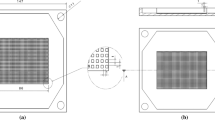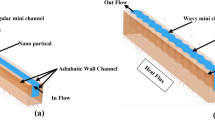Abstract
In this study, 3-D numerical simulations are conducted for single-phase flow and conjugate heat transfer in mini-channel heat sinks subjected to constant heat flux. The effects of using different gallium alloys (EGaInSn, EGaIn, GaSn, and GaIn) and various substrate materials (copper alloy, aluminum, tungsten, and silicon) on the temperature distribution, pumping power, pressure drop, maximum heat flux, and the total thermal resistance are comprehensively investigated for a series of Reynolds number (300–1900). Among all coolants considered, it is found that EGaIn reduces the flow resistance most efficiently. It is also found that the substrate material’s conductivity significantly influences the thermal resistance of the mini-channel. The higher conductivity leads to lower thermal resistance. In addition, when comparing to other gallium alloys, the GaIn alloy with higher thermal conductivity and specific heat shows better thermal performance. Finally, numerical results of the pumping power and pressure drop for gallium alloys are compared and discussed with the prediction by analytical correlations.







Similar content being viewed by others
Abbreviations
- A :
-
Area (m2)
- A sf :
-
Surface area (m2)
- C p :
-
Specific heat (Jkg−1K−1)
- D h :
-
Hydraulic diameter (m)
- f app :
-
Apparent friction coefficient
- f :
-
Friction factor
- H :
-
Channel height (m)
- h :
-
Heat transfer coefficient (Wm−2K−1)
- k :
-
Thermal conductivity (Wm−1K−1)
- K r :
-
Thermal conductivity ratio
- L :
-
Heat sink length (m)
- ṁ :
-
Mass flow rate (kg s−1)
- n :
-
Number of channels
- P :
-
Pressure (Pa)
- Pr:
-
Prandtl number
- q b :
-
Bottom heat flux (Wm−2)
- q max :
-
Maximum heat flux (Wm−2)
- Q :
-
Volume flow rate (m3s−1)
- Q conv :
-
Convective heat flux (Wm−2)
- R tot :
-
Total thermal resistance (K W−1)
- Re:
-
Reynolds number
- T :
-
Temperature (K)
- t b :
-
Base thickness (m)
- u :
-
Velocity component in x-direction
- U in :
-
Velocity at inlet (ms−1)
- v :
-
Velocity component in y-direction
- w :
-
Velocity component in z-direction
- W pp :
-
Pumping power (W)
- W :
-
Heat sink width (m)
- W c :
-
Channel width (m)
- W w :
-
Channel wall thickness (m)
- x hyd :
-
Dimensionless axial distance for hydrodynamic entrance region
- µ :
-
Dynamic viscosity (kg m−1s−1)
- ρ :
-
Density (kg m−3)
- η f :
-
Fin efficiency
- ∆P :
-
Pressure drop (Pa)
- α :
-
Channel aspect ratio
- b:
-
Bottom
- cap:
-
Capacity
- con:
-
Conduction
- conv:
-
Convection
- c:
-
Coolant
- fd:
-
Fully developed
- f:
-
Working fluid
- in:
-
Inlet
- max:
-
Maximum
- o:
-
Output
- s:
-
Heat sink solid part
References
Khalaj AH, Halgamuge SK. A Review on efficient thermal management of air-and liquid-cooled data centers: from chip to the cooling system. Appl Energy. 2017;205:1165–88.
Tzuk Y, Tal A, Goldring S, et al. Diamond cooling of high-power diode-pumped solid-state lasers. IEEE J Quantum Electron. 2004;40(3):262–9.
Qian Z, Li Y, Rao Z. Thermal performance of lithium-ion battery thermal management system by using mini-channel cooling. Energy Convers Manag. 2016;126:622–31.
Tuckerman DB, Pease RFW. High-performance heat sinking for VLSI. IEEE Electron Device Lett. 1981;2(5):126–9.
Wang H, Chen Z, Gao J. Influence of geometric parameters on flow and heat transfer performance of micro-channel heat sinks. Appl Therm Eng. 2016;107:870–9.
Xie XL, Liu ZJ, He YL, et al. Numerical study of laminar heat transfer and pressure drop characteristics in a water-cooled minichannel heat sink. Appl Therm Eng. 2009;29(1):64–74.
Lee PS, Garimella SV, Liu D. Investigation of heat transfer in rectangular microchannels. Int J Heat Mass Transf. 2005;48(9):1688–704.
Ijam A, Saidur R, Ganesan P. Cooling of minichannel heat sink using nanofluids. Int Commun Heat Mass Transf. 2012;39(8):1188–94.
Kim SJ. Methods for thermal optimization of microchannel heat sinks. Heat Transf Eng. 2004;25(1):37–49.
Liu D, Garimella SV. Analysis and optimization of the thermal performance of microchannel heat sinks. Int J Numer Methods Heat Fluid Flow. 2005;15:7–26.
Dang T, Teng JT. Comparisons of the heat transfer and pressure drop of the microchannel and minichannel heat exchangers. Heat Mass Transf. 2011;47(10):1311–22.
Zhang XD, Yang XH, Zhou YX, Rao W, Gao JY, Ding YJ, Shu QQ, Liu J. Experimental investigation of Galinstan based mini-channel cooling for high heat flux and large heat power thermal management. Energy Convers Manag. 2019;185:248–58.
Tawk M, Avenas Y, Lebouc A, Petit M. Numerical study of a liquid metal mini-channel cooler for power semiconductor devices. In: 17th international workshop on thermal investigations of ICs and systems (THERMINIC), Paris, 2011; pp. 1–6.
Dickey MD. Emerging applications of liquid metals featuring surface oxides. Appl Mater Interfaces. 2014;6(21):18369–79.
Spells KE. The determination of the viscosity of liquid gallium over an extended range of temperature. Proc Phys Soc. 1936;48(2):299.
Ma K, Jing L. Liquid metal cooling in thermal management of computer chips. Front Energy Power Eng China. 2007;1(4):384–402.
Liu J, Zhou YX. China Patent No. 02131419, 2002.
Ma KQ, Liu J. Heat-driven liquid metal cooling device for the thermal management of a computer chip. J Phys D Appl Phys. 2007;40(15):4722–9.
Prokhorenko VY, Roshchupkin VV, Pokrasin MA, Prokhorenko SV, Kotov VV. Liquid gallium: potential uses as a heat-transfer agent. High Temp. 2000;38(6):954–68.
Bo G, Ren L, Xu X, Du Y, Dou S. Recent progress on liquid metals and their applications. Adv Phys X. 2018;3(1):1446359.
Evans DS, Prince A. Thermal analysis of Ga–In–Sn system. Metal Sci. 1978;12(9):411.
Zaretabar M, Asadian H, Ganji DD. Numerical simulation of heat sink cooling in the mainboard chip of a computer with temperature dependent thermal conductivity. Appl Therm Eng. 2018;130:1450–9.
Shkarah AJ, Sulaiman MYB, Ayob MRBH, Togun H. A 3D numerical study of heat transfer in a single-phase micro-channel heat sink using graphene, aluminum and silicon as substrates. Int Commun Heat Mass Transf. 2013;48:108–15.
Barbier F, Blanc J. Corrosion of martensitic and austenitic steels in liquid gallium. J Mater Res. 1999;14(3):737.
Tawk M, Avenas Y, Kedous-Lebouc A, Petit M. Numerical and experimental investigations of the thermal management of power electronics with liquid metal mini-channel coolers. IEEE Trans Ind Appl. 2013;49(3):1421–9.
Deng YG, Liu J. Corrosion development between liquid gallium and four typical metal substrates used in chip cooling device. Appl Phys A Mater Sci Process. 2009;95(3):907–15.
Deng YG, Liu J, Zhou YX. Liquid metal based mini/micro channel cooling device. In: Proceedings of 7th international conference on nanochannels, microchannels, minichannels, Pohang, 2009; pp. 22–4.
Luo M, Liu J. Experimental investigation of liquid metal alloy based mini-channel heat exchanger for high power electronic devices. Front Energy. 2013;7(4):479–86.
Zhang R, Hodes M, Lower N, Wilcoxon R. Water-based microchannel and Galinstan-based mini-channel cooling beyond 1 kW/cm2 heat flux. IEEE Trans Compon Packag Manuf Technol. 2015;5(6):762–70.
Yang XH, Tan SC, Ding YJ, Liu J. Flow and thermal modeling and optimization of micro/mini-channel heat sink. Appl Therm Eng. 2017;117:289–96.
Yang XH, Tan SC, Liu J. Investigation of the flow and thermal performance of liquid metal mini-channel-heat sink. J Eng Thermophys. 2019;40(4):916–25 (In Chinese).
Ahmed HE, Salman BH, Kherbeet AS, et al. Optimization of thermal design of heat sinks: a review. Int J Heat Mass Transf. 2018;118:129–53.
Biswal L, Chakraborty S, Som SK. Design and optimization of single-phase liquid cooled microchannel heat sink. IEEE Trans Compon Packag Technol. 2009;32(4):876–86.
Liu D, Zhao FY, Yang HX, Tang GF. Thermoelectric mini cooler coupled with micro thermosiphon for CPU cooling system. Energy. 2015;83:29–36.
Liu S, Sweatman K, McDonald S, Nogita K. Ga-based alloys in microelectronic interconnects: a review. Materials. 2018;11(8):1384.
Hung TC, Yan WM, Li WP. Analysis of heat transfer characteristics of double-layered microchannel heat sink. Int J Heat Mass Transf. 2012;55:3090–9.
Harms TM, Kazmierczak MJ, Gerner FM. Developing convective heat transfer in deep rectangular microchannels. Int J Heat Fluid Flow. 1999;20(2):149–57.
ANSYS Fluent 19.0. ANSYS, Inc. Southpointe 2600 ANSYS Drive Canonsburg, PA 15317.
Patankar SV, Spalding DB. A calculation procedure for heat, mass and momentum transfer in three-dimensional parabolic flows. Int J Heat Mass Transf. 1972;15(10):1787–806.
Incropera FP, DeWitt DP. Fundamentals of heat and mass transfer. 4th ed. New York: Wiley; 1996.
Acknowledgements
This work is supported by the National Natural Science Foundation of China (Grant No. 11802079).
Author information
Authors and Affiliations
Corresponding author
Additional information
Publisher's Note
Springer Nature remains neutral with regard to jurisdictional claims in published maps and institutional affiliations.
Rights and permissions
About this article
Cite this article
Muhammad, A., Selvakumar, D., Iranzo, A. et al. Comparison of pressure drop and heat transfer performance for liquid metal cooled mini-channel with different coolants and heat sink materials. J Therm Anal Calorim 141, 289–300 (2020). https://doi.org/10.1007/s10973-020-09318-2
Received:
Accepted:
Published:
Issue Date:
DOI: https://doi.org/10.1007/s10973-020-09318-2




